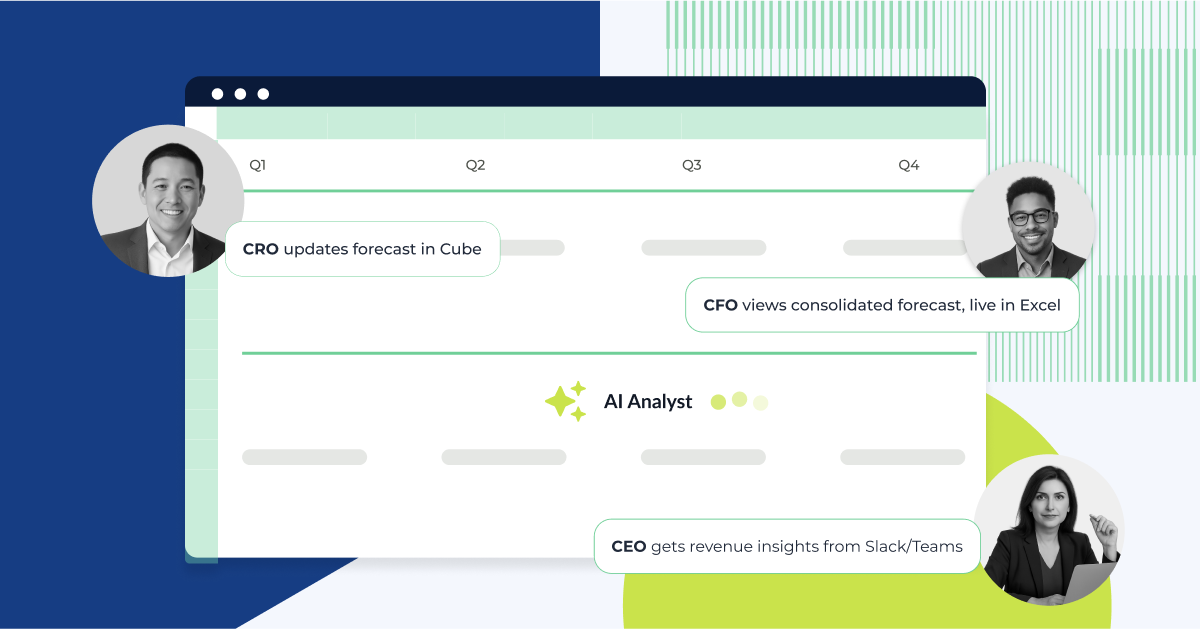FP&A team goals
The FP&A team’s primary objective is to provide insights that drive business decisions while maintaining financial accuracy. This can include:
- Managing a single source of truth about the company’s financial health, as well as customized reports for various stakeholders to use.
- Providing strategic insights to decision-makers on financial planning, risks, and opportunities.
- Identifying cost-saving opportunities where the company can reduce expenditure without sacrificing quality.
- Writing budgets that align business operations with wider financial goals so the whole company can work toward common goals.
- Comparing outcomes of various future scenarios to build a roadmap for scaling.
FP&A team structure and functions
Naturally, an FP&A team has a hierarchy, with more senior roles taking on more responsibility, as we’ll explore below.
Financial Analyst
Financial analysts analyze data, prepare reports, and support budgeting, forecasting, and financial decision-making processes. Junior analysts may take on basic data consolidation, while senior roles might take on more advanced financial modeling and strategic advisory.
As people progress, they will work closer with department heads and leadership and learn how to advance from an analyst to a manager.
FP&A Manager
An FP&A manager oversees financial planning and analysis, supervising forecasts and providing strategic recommendations. They manage a team of analysts and collaborate with other departments to keep the FP&A team on track with financial goals and business objectives.
Depending on the organization's size, an FP&A manager's scope can vary from overseeing a single team to managing multiple units or regions. As they gain experience, they can start positioning themselves to advance from FP&A manager to director.
FP&A Director or VP
FP&A directors and vice presidents (VP) share many responsibilities, and often only large companies need both roles in their hierarchy. They are ultimately responsible for the overall financial strategy and analysis across the company and communicate high-level insights to the executive team.
Directors and VPs often advise on mergers, acquisitions, and other critical financial decisions, scaling their focus as the company grows. Successful directors usually aim to become a VP or Chief Financial Officer after gaining experience in the role.

How to build and scale your FP&A team
Now you know the roles and responsibilities of an FP&A hierarchy, here’s how to build and scale a team that can efficiently reach your company’s goals.
1. Assess the current state of your FP&A team
Whether you're part of an SMB or a larger enterprise, the first step in this expedition is assessing the current state of your FP&A function. It's like checking your climbing gear before the ascent: you need to know what you have, what you lack, and what you aim to achieve.
Just as a seasoned mountaineer prepares for rapid weather changes, so must an FP&A leader prepare for unexpected shifts. Change management is challenging, especially when it comes to people. This three-part change management framework can help you build a roadmap and drive transformation in your finance organization.
- People: Change starts with people and this framework is no different. Remember, every climber needs to feel secure and valued to give their best to the expedition. Offer support, foster open dialogue, and ensure everyone understands their role in the new landscape.
- Processes: Whether adopting a new budgeting process, integrating cross-functional collaboration, or implementing performance metrics, these changes can initially seem overwhelming. However, your team can learn to adapt and thrive with clear communication about the benefits of these new processes.
- Tools: Finally, changes in tools, such as new FP&A software or technologies, can be likened to harnessing new climbing equipment. There might be a learning curve initially, and some might resist letting go of their old, familiar tools. But with proper training and emphasizing the benefits (e.g., greater efficiency, more accurate financial data, and better insights), your team will soon realize this new equipment is a significant upgrade.
The order of operations matters. Building tools around effective processes that support people in delivering results is critical.
2. Define goals and obtain senior management support
The goal of a successful FP&A team is to be a strategic advisor to the business in addition to providing accurate financial forecasts and timely reporting and insights. However, that can look different based on each business's unique needs.
To start, you must set clear, measurable goals for your team. These will serve as the cornerstone of any transformation effort and provide a north star for everyone to point towards.
Questions to answer:
- What are your objectives?
- What needs to be improved?
- What does success look like?
Don't do this work in a silo. Ask your team, senior leaders, various business units, and key stakeholders such as accounting and marketing what they need from finance. Their buy-in will help shape the direction of your transformation and gain buy-in for any changes you make.

3. Evaluating the existing FP&A function and team capabilities
Once goals are defined, you need to create and document a plan to get there. The key here is understanding the current state of your FP&A function and what capabilities you have to work with. Areas to evaluate include:
- Data integrity and quality: How accurate, up-to-date, and reliable is your financial data? Are manual data consolidation processes or outdated systems slowing you down?
- Financial planning: What processes are in place for budgeting, forecasting, and scenario planning? Are they automated or manual?
- Reporting and analysis: How are you collecting, sharing, storing, and analyzing financial and operational data? Are your financial reporting capabilities comprehensive enough to provide data-driven answers and insights? Are your financial statements reliable and accurate?
- Resource allocation and governance: Do you have the right people in the right roles, training, and support? Are there any bottlenecks in decision-making or allocations of financial resources?
- Business partnerships: How well does the FP&A team understand the business and its operations? Do you have relationships with business leaders across the company? An effective FP&A team isn't just about number-crunching; it's about translating those numbers into actionable business strategies and helping to support major corporate decisions.
4. Identifying gaps and areas for improvement
Next, identify the gaps. Just as a climber wouldn't leave a faulty carabiner unchecked, don't ignore the weaknesses in your FP&A function. These might be gaps in skills, technology, or processes. Perhaps your team struggles with data accuracy or financial analysis skills, or the financial reporting process is cumbersome and time-consuming. Recognizing these gaps is the first step towards bridging them. As you start to solve the gaps, prioritize initiatives based on what will provide the most significant benefits and how long they will take to implement.
Remember, scaling your FP&A team isn't just about adding more bodies. It's about creating a team that is agile, efficient, and capable of delivering strategic value to the business and supporting critical business decisions.
Download a free guide on how to grow and scale a top-notch FP&A team.
Key components of FP&A teams
We touched on the key components of FP&A teams earlier—people, processes, and tools—but here, we’re going to go into finer detail.
People: Building a top-tier FP&A team
The most critical component of any FP&A team is the people. Just as every successful climbing team has a clear leader, navigator, and support crew, so must your FP&A team have a well-defined structure and set of roles. Your goal should be to build a highly engaged team, with technical and business acumen and experience across multiple finance disciplines like accounting, treasury, and financial planning and analysis.
Defining team structure and roles
Start by determining the optimal team structure that aligns with your business needs. This isn't a one-size-fits-all solution; it's about finding what works best for your organization. You might opt for a centralized structure where all corporate financial planning and analysis activities are handled by one team. Alternatively, you might prefer a decentralized approach where responsibilities are distributed across several smaller groups. The key is to ensure that your structure promotes efficiency, collaboration, and clear communication.
Next, identify the key roles and responsibilities within your team. This could include corporate financial analysts who handle data consolidation, data analysis, and forecasting, senior analysts responsible for strategic financial planning, and an FP&A manager who oversees the entire operation. Consider mapping out roles and responsibilities using "swimlanes." This visual tool lets you see who owns what, helping avoid confusion and ensuring everyone knows their part in reaching the summit.
Lastly, establish clear career paths and growth opportunities for your team members. Growth motivates your team and helps attract and retain top talent. Whether it's a path to becoming an FP&A manager or a track allowing entry-level financial analysts to move from financial analyst to senior analyst to lead analyst, ensure your team members see a future in your organization.
Recruiting and hiring top talent
With the structure and roles defined, it's time to start recruiting for open positions. First, develop a comprehensive FP&A job description and candidate profile. These should clearly outline the required skills, experiences, and qualifications, the role's responsibilities and expectations, and even the salary range. It's your map to finding the right candidate, so ensure it's detailed and accurate.
Next, utilize effective recruitment strategies such as leveraging professional networking sites, collaborating with universities, or even using recruitment agencies. You can have great success collaborating with universities, especially for corporate financial analyst roles. Remember, attracting qualified candidates is more than just posting a job ad—it's about actively seeking the talent you need.
Finally, conduct thorough interviews and assessments. An interview is your chance to confirm whether candidates have the technical skills needed and if they fit into your team's culture. Remember, you're looking for a skilled climber and a team player who can help you reach the summit.
Training and development
Once you've got your top-tier team, it's time to focus on training and development. Creating a robust onboarding program is crucial. This should familiarize new team members with your organization's operations, culture, and expectations. It's like acclimatizing at base camp before the climb—it prepares your team for the journey ahead.
Once your team is onboarded, provide them with on-the-job training and the ability to build technical and soft skills. Whether it's a workshop on the latest financial modeling techniques or a seminar on effective communication, continuous learning is vital to staying sharp and ready for any challenge.
Finally, encourage professional development and certifications within the FP&A field, such as Chartered Financial Analyst or Financial Modeling & Valuation Analyst. Certifications boost your team's credibility and ensure they stay abreast of industry trends and best practices.
Learn how to build and scale a great FP&A team.
Processes: Enhancing collaboration and performance
As we continue our ascent, it's important to remember that your FP&A team doesn't climb alone. They're part of a larger expedition involving multiple departments working towards a common goal.
Start by fostering collaboration between your FP&A team and other business units. Asking business unit leaders to teach you about their operations before discussing financials helps build trust and understanding. By breaking down silos, you enable your FP&A team to gain a more holistic view of the business and make more informed financial decisions.
Encourage knowledge sharing and information exchange to create an environment where knowledge flows freely. This might involve regular cross-departmental meetings or collaborative platforms.
Lastly, align your FP&A objectives with the broader organization's goals. Whether profit maximization, cost reduction, or market expansion, your FP&A team should understand how their work contributes to these objectives and strive to support them.
Establishing performance metrics and KPIs
With collaboration underway, it's time to establish financial performance metrics and KPIs. These are like your compass and altimeter—they show you where you are and guide you toward your summit.
First, define relevant metrics and KPIs to measure FP&A performance. These could include forecast accuracy, budget variance, or financial close cycle time. Choose metrics that reflect both the efficiency and effectiveness of your FP&A function.
Next, implement a performance management framework for accountability. The framework should clearly outline who is responsible for each metric, how frequently you measure it, and what actions will be taken if targets are unmet. It's about ensuring everyone knows their role in the climb and holds themselves accountable.
Finally, regularly evaluate and adjust your metrics based on business needs. As your organization grows and changes, so should your performance metrics, ensuring that your FP&A team continues to focus on what matters most and stays on the right path to the summit.
Tools: Data integrity and technology
As any experienced mountaineer knows, reliable equipment is crucial for a successful climb. In the world of FP&A, your data is one of the most critical pieces of equipment you have. Let's explore how to ensure its accuracy and integrity.

Ensuring financial data accuracy and integrity
Start by implementing data governance practices and protocols. This involves establishing rules and standards for data collection, storage, and usage. Think of it as the safety guidelines for your climb—they ensure that everyone handles the data correctly and consistently.
Next, validate and reconcile your historical data sources for accuracy. Quality control involves cross-checking data from different sources or using software tools to detect and correct errors. It's like double-checking your gear before the climb—you want to ensure everything is in order.
Lastly, establish data quality controls and ensure data security by regularly auditing your data for quality issues and protecting it from unauthorized access or loss. Remember, your data is not just a tool for decision-making; it's also a valuable asset that needs to be protected.
Implementing effective tools, technology, and financial reports
With your data in check, let's turn our attention to the other tools in your FP&A toolkit. First, evaluate and select the right FP&A software and tools. These should align with your team's needs and capabilities, providing budgeting, forecasting, reporting, and analysis functionalities. When selecting, consider factors like ease of use, scalability, integration capabilities, and cost.
Next, integrate data analytics and reporting capabilities. Data visualization tools can help your team transform raw data into actionable insights and present them clearly, and visually appealingly. It's like having a high-powered telescope on your climb: it allows you to see further and make more informed decisions.
Finally, leverage automation to streamline processes and increase efficiency. Automation not only saves time but also reduces the risk of human error.
Empower your FP&A team to scale and succeed
Growing and scaling your FP&A team to meet the evolving needs of your business can feel like an uphill battle. Luckily, with the right tools and strategies, you can conquer the climb.
Cube takes care of the tech side by integrating complex financial planning and analysis functions into your existing spreadsheets and software tools. To learn more about how Cube can help you grow and scale your FP&A team, register for a free demo with our team today.



.png)









.png)

![FP&A team structure, responsibilities, and how to scale [2025]](https://www.cubesoftware.com/hubfs/budgeting-best-practices%20(1)-1.webp)




.png)
![Best strategic planning software for CFOs [2025 review]](https://www.cubesoftware.com/hubfs/Frame%2014-1.png)
